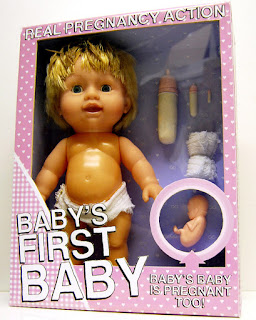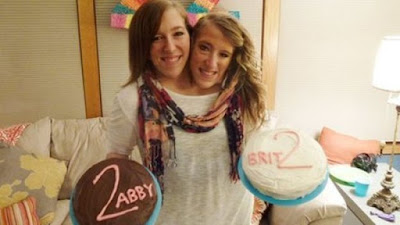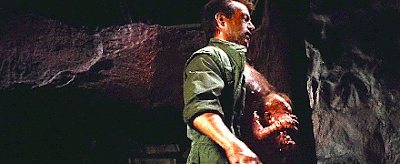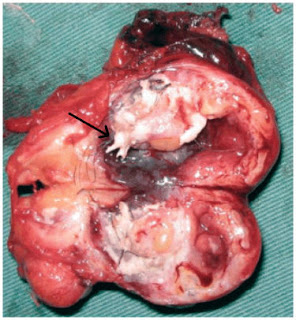Biology Concepts – conjoined twins, resorbed twin, monozygotic twin, spina bifida, fetus in fetu, vanishing twin
The girls represent a form of conjoined twins called symmetrical or equal. Each twin is developed to the same degree as the other. Even for symmetric conjoined twins, Abby and Brittany are unusually symmetric. Many of their internal organs are doubled; each has their own heart, spleen, stomach and spinal column.
Unfortunately, this isn’t always the case. All conjoined twins are termed imperfect, since the single embryo did not split completely, but some are more imperfect than others. Remember that 40-60% of conjoined twins are stillborn; we only see the miracles where they can be separated or where they can function and grown up to be strong, independent people.
Asymmetrical, or unequal conjoined twins lie along a continuum. In some instances, one twin is slightly larger and stronger, even in symmetrical cases like Brittany and Abby, Abby’s leg is two inches taller than Brit’s, so Brittany has a larger calf muscle from standing on her tip toes all the time. In other cases, one twin is unrecognizable as a small tumor in the body of the other twin, but more on that later.
If one asymmetrically conjoined twin is much larger and healthier than the other, it can have it’s health put at risk by the parasitic twin(ie. the smaller, less developed twin is terms the parasite). In many cases, the parasitic twin is dependent on the autosite (larger twin) for survival because he/she does not have a complete cardiovascular system of his/her own.
Despite it’s weaker state, the parasitic twin does survive to delivery because it gains energy and oxygen from the larger twin. Remember that these are conjoined twins, so they will share a blood system. This is why the otherwise doomed parasitic twin can live before and after delivery. This is one characteristic that distinguishes parasitic twinning from conditions like absorbed twin or vanishing twin (see below).
In a newly described case, one set of rachipagus (joined at the spine) conjoined twins consisted of an individual whose only indication that they had a twin was a single leg extending from his back.
And sometimes it isn’t even that simple to see the twin. Spina bifida is an all too common congenital defect in which the spinal column and backbone do not close completely. There are varying degrees of spina bifida; including a mild form (occulta) in which has perhaps a dimple or some hair and no symptoms and a severe form (myelomengiocele) where the spinal column could be open to the environment. One reported case of parasitic twins consisted of a conjoined twin hidden within the defect of a spina bifida patient (2012).
Then there was a 2005 case in Egypt where the young boy had a parasitic twin that consisted of only a head. The head was located on the surface of the larger twin’s body. It could blink, cry, and even smile. The parasite didn’t cause the death of the larger twin, but he did unfortunately die from an infection obtained from the surgery undertaken to remove his sibling.
In other cases, the parasitic twin is completed enveloped in the larger twin’s body. The tissue is still alive, but invisible to the naked eye. This is sometimes called fetus in fetu (fetus within a fetus). But the definition is a bit more involved. Most fetus in fetu cases have a specific location in the body, the retroperitoneal space.
 |
Kind of silly, but this is how fetus in fetu got its name. A baby is born and it has a small fetus inside its abdomen. It looks like the baby is pregnant; ie. fetus in a fetus. In real life, some aphid insects are born pregnant (see this post). |
However, if the axes are maintained and the tissues are organized, the site of the mass can be given a bit of leeway and still term the case as fetus in fetu. Amazingly, there is a case described in which the parasitic twin was found in the cranial cavity of the surviving twin, and even one where the twin mass was found in the scrotum of the survivor!
Even weirder, a case reported in India described two fetuses within the abdominal cavity of their male sibling. Talk about a bully, he ate his siblings. Notice that most of these cases involve boys as the surviving individual. The known cases of fetus in fetu have a strong male predilection. Is there something genetic there, or is it the difference in how parents treat boys and girls? Maybe not.
When tissue is not viable, many things can happen, including calcification. Calcium can get added to the tissues so that the body kind of walls it off. This happens to some fetus in fetu tissues if they lose their blood supply as they grow. It can also happen in cases where the twin passes away while still in the uterus and is then absorbed by the surviving fetus.
Appropriately enough, these are called absorbed twins or resorbed twins. Like fetus in fetu, absorbed twins end up inside the other twin. Unlike fetus in fetu or parasitic twins, absorbed twins don’t have to be conjoined twins and the absorbed twin is not alive. They don’t even have to be MZ twins; they usually are, but they could be any type of multiples.
 |
Dwight Schrute bragged that he grew strong by reabsorbing his twin in the womb. If his twin is still inside him, he resorbed it. If there’s no evidence, then it’s a vanished twin. |
Absorbed twins can cause some problems that other types of twins can’t. For instance, there is the potential to misdiagnose a trisomy or other nondisjunction problem (see this post) because there is extra DNA floating around in the amniotic fluid.
The mass of tissue that was a twin can be found just about anywhere in the body - but it doesn’t have to be a mass. In some cases, the twin tissues can be flattened against growing tissues of the other fetus and ends up paper thin and spread out – fetus papyraceous. This condition occurs about once in every 200 twins pregnancies, so it is not too uncommon in multiple gestations.
In vitrofertilization (IVF) techniques are increasing the rates of MZ twinning, dizygotic twinning, parasitic twinning (including fetus in fetu) and absorbed twins. As we said above, as many as 25% of pregnancies with more than one embryo could end up losing an individual to one of these phenomena.
One of these possible outcomes is closely related to absorbed twin. If the reabsorption comes early in the pregnancy with little or no evidence of the absorbed twin found in the survivor, then it can be called a vanished twin.
The vanishing twin becomes non-vital in utero, but it usually occurs earlier in the pregnancy and is diagnosed by ultrasound. The mother will have an image taken at, say, four weeks gestation, and there will be X number of small embryos implanted and developing placentas and amniotic sacs. Two weeks later she will be imaged again, and there will be one or two fewer embryos and amnions. The other(s) vanished; hence the name.
You may have heard of a teratoma. Many people use the term teratoma when fetus in fetu/absorbed twin/vanishing twin would be more appropriate. While they may appear similar, they have different origins. A teratoma is a tumor of stem cells, not the result of changes in an embryo. As they grow and propagate, some teratoma cells will start to differentiate into specific cell types – they are pluripotent after all. Teratomas may include fully or partially formed teeth, hair, and other recognizable structures, but there is no organization to the growth as one would see in fetus in fetu or an absorbed twin.
Today’s subjects have been interesting, but kind of a downer. Next week let’s talk about some happier kinds of MZ twins. There are several types, and they’re definitely not identical.
For more information or classroom activities, see:
No real classroom activities for lost twins, thank goodness.


